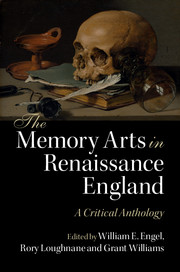Book contents
- Frontmatter
- Dedication
- Contents
- List of figures
- Acknowledgements
- A note on abbreviations
- Introduction
- PART I The art of memory
- Introduction to Part I
- I.1 Stephen Hawes, The Pastime of Pleasure (1509)
- I.2 [Laurence Andrewe], The Mirror of the World (1527)
- I.3 Peter of Ravenna, The Phoenix (1548)
- I.4 Guglielmo Gratarolo, The Castle of Memory (1562)
- I.5 Hugh Plat, The Jewel House of Art and Nature (1594)
- I.6 William Basse, A Help to Memory and Discourse (1620)
- I.7 John Willis, The Art of Memory (1621, 1661)
- I.8 Henry Herdson, Ars memoriae; the Art of Memory Made Plain (1651)
- I.9 Richard Saunders, Art of Memory (1671)
- I.10 Marius D'Assigny, The Art of Memory (1697)
- PART II Rhetoric and poetics
- PART III Education and science
- PART IV History and philosophy
- PART V Religion and devotion
- PART VI Literature
- Index
Introduction to Part I
from PART I - The art of memory
Published online by Cambridge University Press: 05 August 2016
- Frontmatter
- Dedication
- Contents
- List of figures
- Acknowledgements
- A note on abbreviations
- Introduction
- PART I The art of memory
- Introduction to Part I
- I.1 Stephen Hawes, The Pastime of Pleasure (1509)
- I.2 [Laurence Andrewe], The Mirror of the World (1527)
- I.3 Peter of Ravenna, The Phoenix (1548)
- I.4 Guglielmo Gratarolo, The Castle of Memory (1562)
- I.5 Hugh Plat, The Jewel House of Art and Nature (1594)
- I.6 William Basse, A Help to Memory and Discourse (1620)
- I.7 John Willis, The Art of Memory (1621, 1661)
- I.8 Henry Herdson, Ars memoriae; the Art of Memory Made Plain (1651)
- I.9 Richard Saunders, Art of Memory (1671)
- I.10 Marius D'Assigny, The Art of Memory (1697)
- PART II Rhetoric and poetics
- PART III Education and science
- PART IV History and philosophy
- PART V Religion and devotion
- PART VI Literature
- Index
Summary
The classical art of memory (memoria), a private technique for aiding oratorical delivery (actio) in a public arena, clung on as a curious relic of a primarily oral culture in the medieval period – a time when the written word surpassed the spoken. Neglected in the public forum of the Middle Ages, the art was primarily used by monks as a compositional and meditative technique. The Dominican friars Albertus and Aquinas advocated the artificial memory, drawing on Cicero's conception of memoria as one of the three component parts of Prudence in De inventione (along with intelligentia and providentia). In theory, their advocacy of the use of the artificial memory supported the individual's use of memorable imagery to aid private devotional practice and prompt devout work in the world; in practice, in a wider sphere, it influenced the use of striking didactic imagery in late medieval and Renaissance Christian visual culture. Its influence has been identified in the design of visual alphabets, heraldic signs, stained glass windows, frescoes and friezes, figure poems, striking imagery on carved stone wall adornments, and, of course, emblem books. The underlying precepts of the Scholastic appropriation of the art of memory – ordered, coded associations based on repeated evocative imagery to instruct prudential behaviour – can also be identified in cultural practices and movements, such as the ars moriendi, danse macabre and memento mori traditions, in educational practices, such as the dissemination of popular and sacred history in spectacles, such as Corpus Christi processions, and even the composition of music and musical systems.
However, the Scholastic advocacy of Ciceronian artificial memory represents only one strand of transmission to later culture. Important also were the religio-philosophical writings of the Majorcan Franciscan missionary Ramon Lull. Lull's combinatorial art (ars combinatoria), rooted in Augustinian Platonism's conception of the presence of divine realities in the soul, sought to classify knowledge by breaking down ‘compound concepts into simple and irreducible notions’. In effect, using letters and symbols to represent these irreducible notions, which could be combined in various ways, Lull created an artificial universal language based upon the attributes of God (Dignitates Dei). Such a Christian scheme organised around the divine attributes or names of God has much in common with cabalist meditation in Jewish mysticism.
- Type
- Chapter
- Information
- The Memory Arts in Renaissance EnglandA Critical Anthology, pp. 35 - 38Publisher: Cambridge University PressPrint publication year: 2016



